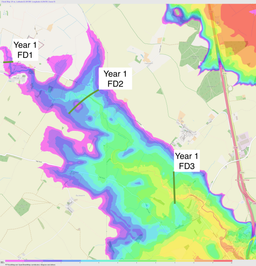
Alconbury Flood Group Research
Update
The Alconbury Brook Flood Group Research
Project 1: Holding more water in soil
Summary: The Alconbury Brook Catchment has mostly heavy clay soils. Clay soils have plenty of air and water space, but because the particles are small, water passes through slowly and runs off quickly when it rains.
Farmers get grants for sowing pasture and boundary strips which improve soil quality.
Plants roots, soil fungi and worms all engineer the soil to make it soak up more water.
Our project is looking at improving the mix of plants and management of pasture to improve how water soaks into the soil.
Latest News
April 2023 Testing of a field in Gidding to count different types of worms and measure how compact the soil is. The soil water capacity in the test field is about 35%.
July 2023 After a lot of testing the Gidding field shows as already rich in deep rooted plants which help rain water infiltration and high in organic material. We have extended the scope of the experiment to look infiltration and carbon by other plant mixtures on the same farm and one or two other locations. We are also delighted to say that our funding for this research project has been approved.
Project 2: Movement of sediment in the brook
Summary: Sediment is mostly agricultural soil which has been washed off the land during rainfall. It is a farms basic asset.
Most sediment is carried along the brook when it is flowing after rain. For example on April 15th after heavy rain the night before, the brook was carrying 2.5 tonnes of sediment per hour.
Some sediment builds up in semi-permanent islands and berms which reduce flow in the brook. Many of the islands match places where road and field drains run intpo the brook
Our project is looking at a number of sediment islands to look at how they change with flow and rainfall.
Our pond projects and a storage dam are ways of trapping sediment before it gets to the village sections of the brook.
Latest News
April 2023: Measurement of flow and sediment levels in the brook. For example when it flows at 0.2m/s hardly any sediment is carried, most is dropped.
Mapping of some sediment islands before read growth.
July 2023:
Flood Group has been testing brook water in various places for a number of dissolved chemicals.
The EA is looking at running a citizen science project in part of the catchment to look at the origins of downstream sediment. The EA is also looking at a second collaborative project measuring microplastics in some small watercourses.
We need your consent to load the translations
We use a third-party service to translate the website content that may collect data about your activity. Please review the details in the privacy policy and accept the service to view the translations.

